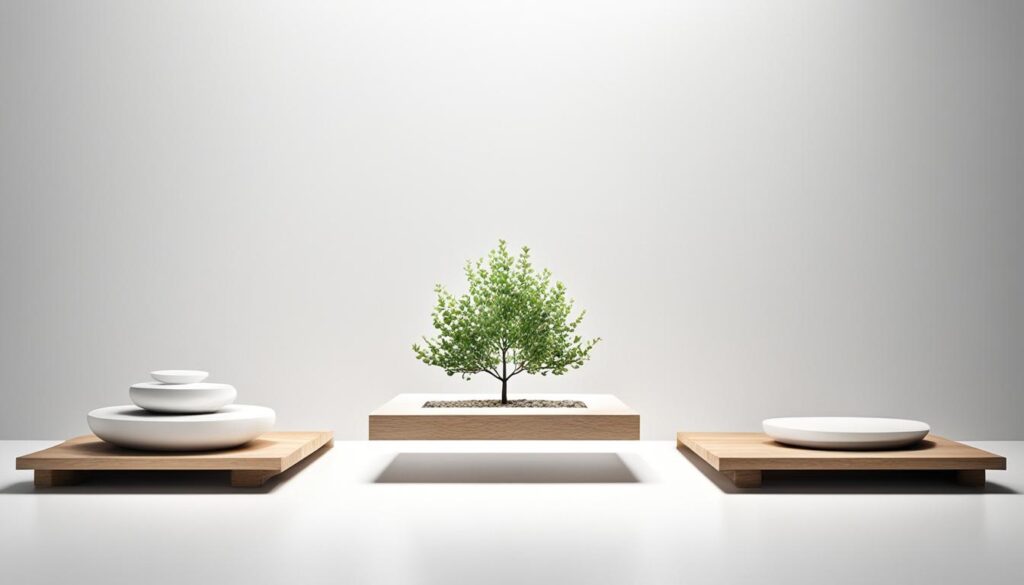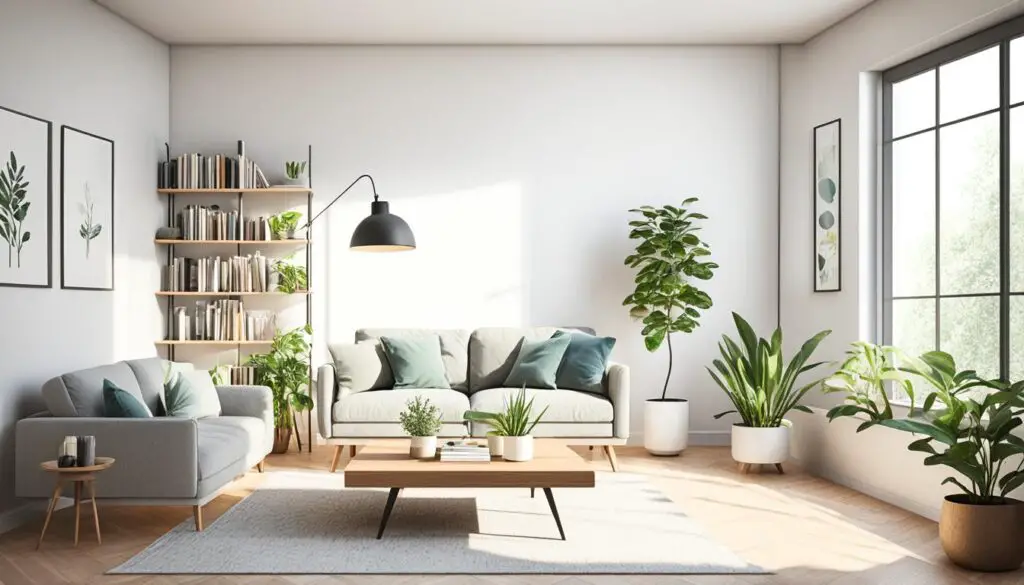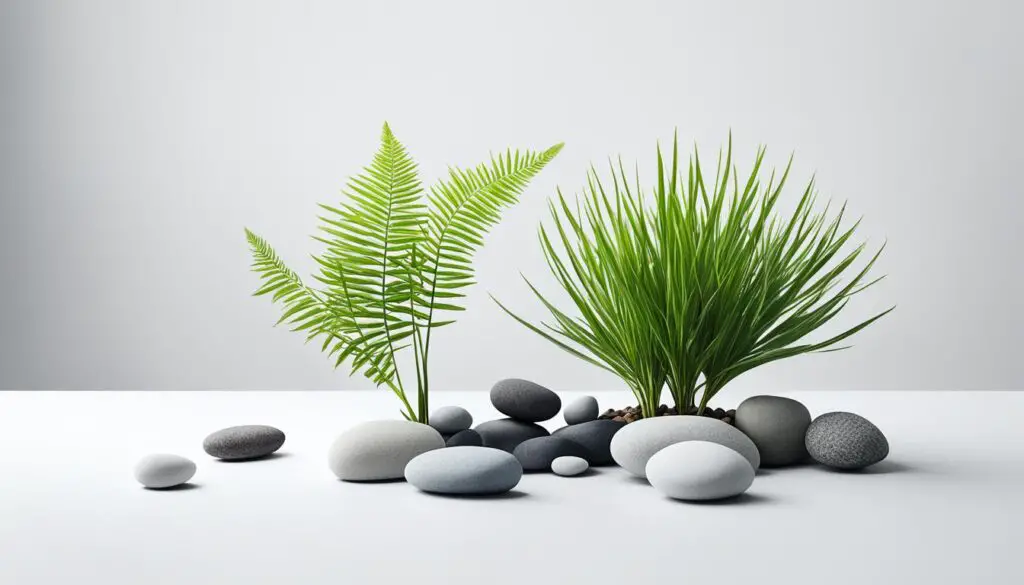Minimalism emerged as an artistic, cultural and philosophical movement in the United States, in the late 50s and early 60s. It focused on a minimum of resources and elements, reducing aspects of works to the essential. Minimalism had a significant impact on visual arts, architecture, design, music, and visual programming throughout the XNUMXth century.
- Minimalism emerged as an artistic, cultural and philosophical movement in the United States
- The goal of minimalism is to reduce resources and elements to their essentials
- Minimalism has had a significant impact on visual arts, architecture, design, music and visual programming
- A philosophy of minimalism is to seek to adapt to life only what is essential
- Minimalism has influenced many fields, such as architecture, interior design and lifestyle.
Characteristics of Minimalism
As characteristics of minimalism they encompass austerity, synthesis and abstraction. Minimalism, philosophically, seeks to simplify life, focusing only on the essentials and eliminating the superfluous. In the visual arts, minimalism manifests itself through abstract and “raw” works, revealing the industrial origin and nature of the materials used. Valuing simple, pure, symmetrical and repetitive geometric shapes, minimalism in the visual arts expresses a refined and sophisticated aesthetic. The absence of emotionality is common in minimalist representations, emphasizing neutrality and a focus on the form and structure of the works.
Main characteristics of minimalism:
- Austerity
- Synthesis
- Abstraction
| Characteristics of Minimalism | Overview |
|---|---|
| Austerity | Search for simplicity, eliminating unnecessary elements. |
| Synthesis | Reduction of elements to the essential, highlighting form and structure. |
| Abstraction | Artistic expression without realistic references, emphasizing the purity of form. |
Minimalism transcends the visual arts and extends to other aspects of life, influencing design, architecture, lifestyle and even philosophical thought. By adopting minimalist principles, we can value what really matters and enjoy a simpler, more balanced and meaningful life.

Minimalism in the Visual Arts
O minimalism in the visual arts emerged in New York in the 1950s. The artists of this movement used few elements in their works, exploring visual attributes using a small number of colors. They favored simple, pure and repetitive geometric shapes. O minimalism in the visual arts was influenced by the constructivist current and had important artists such as Sol LeWitt, Frank Stella, Donald Judd and Robert Smithson.
Those minimalist artists they sought to create works that highlighted the essence of form and space, without adornments or superfluous elements. Simplicity was fundamental to convey the visual message of his works.
A striking example of the minimalism in the visual arts is the work “Compositions in Color” by Sol LeWitt. In this series of paintings, LeWitt uses simple geometric shapes, such as squares and rectangles, and primary colors to explore the interaction between shapes and the viewer's visual perception.
The influence of minimalism on the constructivist current
Minimalism in the visual arts was strongly influenced by the constructivist current, which emerged in Russia at the beginning of the 20th century. Constructivist artists sought to create works that reflected the ideals of industrial society, using industrial forms and materials in their creations.
This influence is evident in the minimalist works, which also use industrial materials, such as steel and concrete, and explore simple and pure geometric shapes. The simplicity of forms and the absence of adornments are common characteristics of both minimalism and constructivism.
“Minimalism in the visual arts seeks to eliminate the superfluous, valuing the essential and the simplicity of shapes and colors.” – Sol LeWitt
Another important minimalist artist is Frank Stella, known for his paintings with abstract geometric shapes. His work “Die Fahne Hoch!” uses straight lines and bright colors to create a dynamic and impactful composition.
Donald Judd and Robert Smithson are also important names in minimalism in the visual arts. Judd created sculptures with repetitive and symmetrical shapes, exploring the relationship between the work of art, space and the viewer. Smithson is known for his land art works, which use natural elements and interventions in the environment to create a unique visual experience.

Minimalism in the visual arts had a significant impact on the artistic scene, questioning traditional concepts of art and proposing a new approach. This search for the essence of shapes and colors continues to influence contemporary artists and contribute to the diversity and evolution of visual arts.
Minimalism in Design
O minimalism in design It is characterized by formal simplicity and the use of neutral colors. It emerged as an opposition to postmodern movements and values simplicity and functionality, seeking to eliminate superfluous elements and emphasize the essential.
Minimalist designers seek to create environments and objects that are visually clean, without excess ornaments and details. This minimalist approach allows form and function to be highlighted, resulting in designs that are elegant and timeless.
One of the fundamental principles of minimalist design It's simplicity. Elements are reduced to the minimum necessary, resulting in simple and pure geometric shapes. Straight lines and sharp corners are common, giving a sense of order and harmony.
The use of neutral colors, such as white, black, gray and earthy tones, is a striking feature of the minimalist design. These colors create a feeling of calm and tranquility, as well as allowing objects and elements to stand out in a discreet way.
Simplicity is the greatest sophistication. – Leonardo da Vinci
O minimalism in design It has influenced many fields, from architecture and interior design to digital products and interfaces. Some notable minimalist designers include:
- Philippe Starck: known for his innovative and functional creations, Starck is an exponent of minimalist design contemporary.
- Shiro Kuramata: famous for his creative use of materials and his minimalist approach to furniture and objects.
- John Pawson: known for his neutral color palette and his search for simplicity and harmony in his architectural creations.

O minimalism in design continues to be an influential and relevant approach, providing aesthetically pleasing, functionally efficient and emotionally serene environments and objects. Its focus on simplicity and valuing the essentials has gained more and more followers in search of a more uncomplicated and conscious life.
Minimalism in Music
In music, minimalism is a style that stands out for its composition with few notes, creating a pulsating and hypnotic rhythm through the harmonic repetition of small sections. You minimalist composers are known for their simplified and focused approach, exploring the possibilities of repetition and variation to create immersive sonic atmospheres.
One minimalist composers most famous is Philip Glass. His works are marked by rhythmic repetitions and modal harmonies, generating a sensation of continuous movement and contemplation. Glass's minimalism stands out for its structural clarity and economy of musical elements.
Another prominent minimalist composer is Steve Reich, known for his percussive and polyrhythmic compositions. His works often feature short, repetitive melodic phrases that move at different speeds, creating complex and emotionally impactful sound layers.
Arvo Pärt is another renowned minimalist composer, famous for his contemplative and spiritual compositions. His music is characterized by a minimalist approach in which simple melodic lines and slow harmonies combine to create moments of beauty and serenity.

O minimalism in music has influenced many genres and artists over time. His approach of simplicity, repetition and immersive atmosphere continues to inspire and captivate listeners around the world.
Minimalism in Literature
O minimalism in literature It is a style characterized by the production of mini-stories, in which the economy of words and the suggestion of contexts are fundamental. You minimalist writers are known for their ability to convey stories and emotions in a concise and impactful way.
Two of minimalist writers The most renowned are Raymond Carver and Ernest Hemingway. Both are known for their minimalist writing, which uses few words to create deep and intense stories.
“Oh, my God…, I murmur. But she doesn't hear that. So I follow. I go into the living room and close the door.”_Raymond Carver
Raymond Carver is considered one of the masters of minimalism in literature. His short stories portray the everyday lives of ordinary people, with an economical language and a focus on the subtleties of everyday life.
“It was covered in snow for mile after mile on all sides. Dr. Adams put me in that jeep. After turning a corner, he showed me the city.”_ Ernest Hemingway
Ernest Hemingway is another writer who marked minimalist literature with his lean and direct prose. His novels and short stories often portray characters in adverse situations, with an objective style and short sentences that evoke intense feelings.
Minimalist Methods in Literature
Os minimalist writers They use specific techniques to convey emotions and tell stories succinctly. Some of these methods include:
- Use of short and concise dialogues
- Elimination of unnecessary descriptions
- Emphasis on subtext and between the lines
- Use of metaphors and symbols
These techniques allow minimalist writers to create powerful and resonant narratives, even with an economy of words.

| Writer | Outstanding works |
|---|---|
| Raymond Carver | What We Talk About When We Talk About Love Cathedral Elephant |
| Ernest Hemingway | The old and the sea For Whom the Bell Tolls Paris is a Party |
The table above presents some of the main minimalist writers and their best-known works. These authors were pioneers in exploring brevity and suggestion in literature, leaving a lasting mark on the field of minimalist writing.
Emergence of Minimalism
Minimalism emerged as an artistic movement in the United States in the 1960s. Initially, it was a movement that sought to simplify and reduce elements in works of art. Over time, minimalism expanded beyond art, becoming a lifestyle focused on eliminating excess and valuing the essential.

Minimalism emerged as a response to the post-Second World War artistic context, in which consumerism and mass consumerism were on the rise. You minimalist artists They sought to distance themselves from this excessive consumerism, simplifying their works as much as possible.
"Less is more." – Ludwig Mies van der Rohe
Os minimalist artists They rejected the idea that works of art should be complex and full of meaning. Instead, they focused on eliminating any unnecessary elements, creating works that convey a sense of calm and serenity.
Top minimalist artists
| Artist | Works |
|---|---|
| Donald Judd | Untitled (Stack) |
| Dan flavin | Untitled (to Jan and Ron Greenberg) |
| Anne Truitt | Summer Dryad |
Minimalism has had a lasting impact on visual arts, architecture, design, and even people's lifestyles. Nowadays, many individuals adopt minimalism as a philosophy of life, seeking to get rid of excess and focus on what is essential.
Influences of Minimalism
Minimalism has had a significant impact on many fields, from architecture to lifestyle. The minimalist philosophy values simplicity and the reduction of excess, influencing the way we design spaces, live and consume.
In architecture, minimalism translates into clean, uncluttered spaces, with straight lines and few decorative elements. Minimalist environments prioritize functionality, intelligent use of space and integration with nature. Here is a notable example of a minimalist design:

“Minimal architecture has the ability to create spaces that promote calm and contemplation, allowing people to focus on the essentials and find inner peace.”
– Renowned architect
In interior design, minimalism manifests itself in clean spaces, with few furniture and objects, neutral colors and simple lines. This style promotes visual harmony, a feeling of organization and a calm and serene atmosphere.
Minimalism has also had a huge impact on lifestyle, encouraging slowing down, digital disconnection and the search for authentic experiences. Followers of minimalism seek to reduce unnecessary consumption, value quality over quantity and live in a more conscious and sustainable way.
Furthermore, minimalism influenced the conscious consumption movement, which seeks to rethink the way we acquire and discard objects. The idea is to avoid waste and look for durable, quality products, helping to reduce damage to the environment.
Benefits of Minimalism Influences
As minimalism influences bring several benefits to individuals and society as a whole. Some of these benefits include:
- Greater feeling of calm and tranquility;
- Lower stress and anxiety;
- Greater mental clarity and focus on priorities;
- Financial savings and reduction of unnecessary consumption;
- Contribution to the preservation of the environment;
- Improves organization and productivity;
- Creation of more functional and efficient spaces;
- Promotion of a more conscious and sustainable lifestyle.
To adopt minimalism influences in different areas can bring many benefits to both the individual and the environment. Simplicity, functionality and valuing the essentials are pillars that can lead to a more balanced and satisfying life.
How to be a Minimalist in Everyday Life
Being a minimalist in everyday life involves adopting practices such as conscious consumption, evaluating the objects present in life, avoiding excessive purchases and building a minimalist wardrobe. Starting small and making conscious choices are important steps to adopting the minimalist lifestyle.
When it's about how to be minimalist, the first step is to practice conscious consumption. This means thinking carefully before purchasing something new and considering whether it is really necessary. Evaluate whether the item will bring value and usefulness to your life before purchasing it. This way, you will avoid accumulating unnecessary things and help reduce your environmental impact.
Furthermore, it is essential to evaluate the objects that are already part of your life. Review your possessions and ask yourself whether each item is still relevant and brings you happiness. Get rid of what you no longer need by donating, selling or discarding consciously. This process of detachment will free up physical and mental space, bringing more lightness to your daily life.
Avoiding excessive purchases is another essential aspect of minimalist lifestyle. By adopting minimalism, you become more selective in relation to your purchases and seek to invest in durable, quality items. Prioritize functionality and versatility, looking for timeless pieces that match each other. This way, you build a minimalist wardrobe and avoid wasting financial and material resources.
Finally, being a minimalist in everyday life requires a gradual process and conscious choices. This is not an instant change, but rather a journey towards a simpler and more meaningful lifestyle. Start by implementing small changes in your daily life and see how they impact your quality of life. Over time, you will develop a sense of aesthetics and priorities that align with minimalism.

Benefits of Minimalism
Minimalism offers a number of significant benefits, ranging from a more focused life to contributing to environmental and animal causes. By adopting minimalism, it is possible to experience advantages such as reduced environmental impact, financial savings and more organized environments. Furthermore, the minimalist philosophy promotes better management of resources and brings clarity to life's priorities.
Here are some benefits of minimalism:
- Financial savings: When adopting a minimalist lifestyle, it is possible to reduce unnecessary expenses, avoid impulse purchases and prioritize what is truly essential. This can result in significant savings in the long term.
- Reducing environmental impact: Minimalism encourages reducing consumption and valuing durable and sustainable products. By living with fewer material resources, it is possible to reduce the impact on the environment, contributing to the preservation of natural resources.
- More organized environments: With fewer belongings and a minimalist approach to organization, it is possible to create more orderly and clutter-free spaces. This provides a feeling of calm and tranquility in the home environment.
- Contribution to environmental and animal causes: Minimalism can inspire the adoption of conscious and sustainable consumption practices, contributing to causes such as reducing waste, protecting animals and preserving nature.
- More focused life: Minimalism emphasizes the importance of prioritizing the essentials and eliminating unnecessary distractions. By reducing the number of commitments, belongings and tasks, it is possible to have a more focused life and with more time for meaningful activities.
Minimalism offers a mindful and balanced approach to life, allowing individuals to connect with what truly matters. By adopting a minimalist lifestyle, you can enjoy tangible and intangible benefits, resulting in a fuller and more meaningful life.

Conclusion
Minimalism emerged as an artistic movement in the 60s and expanded beyond the arts, influencing many fields. It is characterized by simplicity, synthesis and simplicity, seeking to value the essential and eliminate excess. Minimalism has benefits for both the individual and the environment, contributing to a more sustainable and conscious lifestyle.
By adopting minimalism, we can experience a more focused life free from the excesses that attack us daily. With fewer objects, more organization and better management of resources, it is possible to create harmonious and inspiring environments. Furthermore, being a minimalist also implies reducing environmental impact, practicing conscious consumption and contributing to environmental and animal causes.
In short, minimalism provides a change of perspective, leading us to question what is really important to us and to value what is essential. It's an invitation to live with less, direct our focus to what really brings us happiness and seek a more authentic and meaningful life. Therefore, it is worth considering the principles of minimalism and exploring the benefits it can bring to our lives.
FAQ
Q: Why did minimalism emerge?
A: Minimalism emerged as an artistic, cultural and philosophical movement in the United States in the late 50s and early 60s. Initially, it sought to simplify and reduce elements in works of art, but it expanded beyond the arts, becoming a lifestyle focused on eliminating excess and valuing the essentials.
Q: What are the characteristics of minimalism?
A: The characteristics of minimalism include austerity, synthesis and abstraction. Philosophically, he seeks to adapt only what is essential to life, leaving aside the superfluous. In the visual arts, it is expressed through abstract and “raw” works, valuing simple and pure geometric shapes, symmetrical and repetitive, with an absence of emotionality in the representations.
Q: How did minimalism appear in the visual arts?
A: Minimalism in the visual arts emerged in New York in the 1950s. The artists of this movement used few elements in their works, exploring visual attributes using a small number of colors. They favored simple, pure and repetitive geometric shapes. Some important artists from this current are Sol LeWitt, Frank Stella, Donald Judd and Robert Smithson.
Q: What is minimalism in design?
A: Minimalism in design is characterized by formal simplicity and the use of neutral colors. It emerged as an opposition to postmodern movements and values simplicity and functionality. Some well-known minimalist designers are Philippe Starck, Shiro Kuramata and John Pawson.
Q: What is minimalism in music?
TO THE minimalism in music stands out for its composition with few notes, creating a pulsating and hypnotic rhythm through the harmonic repetition of small sections. minimalist composers Famous ones include Philip Glass, Steve Reich and Arvo Part.
Q: What is minimalism in literature?
TO THE minimalism in literature is characterized by the production of mini-stories, focusing on saving words and suggesting contexts. Renowned minimalist writers are Raymond Carver and Ernest Hemingway.
Q: What is the history of minimalism?
A: Minimalism emerged as an artistic movement in the United States in the 1960s, seeking to simplify and reduce elements in works of art. Over time, it expanded beyond the arts, influencing various fields, such as architecture, interior design and the minimalist lifestyle.
Q: What are the influences of minimalism?
A: Minimalism has had significant influences in several fields, such as architecture, interior design, lifestyle and even conscious consumption. It values the slowdown in the process of using and discarding objects, contributing to reducing damage to the environment.
Q: How to be minimalist in everyday life?
A: Being a minimalist in your daily life involves adopting practices such as conscious consumption, evaluating the objects present in your life, avoiding excessive purchases and building a minimalist wardrobe. Starting small and making conscious choices are important steps towards adopting a minimalist lifestyle.
Q: What are the benefits of minimalism?
To the benefits of minimalism include a more focused life, reduced environmental impact, financial savings, more organized environments and contributions to environmental and animal causes. It allows for better management of resources and greater clarity in life priorities.






